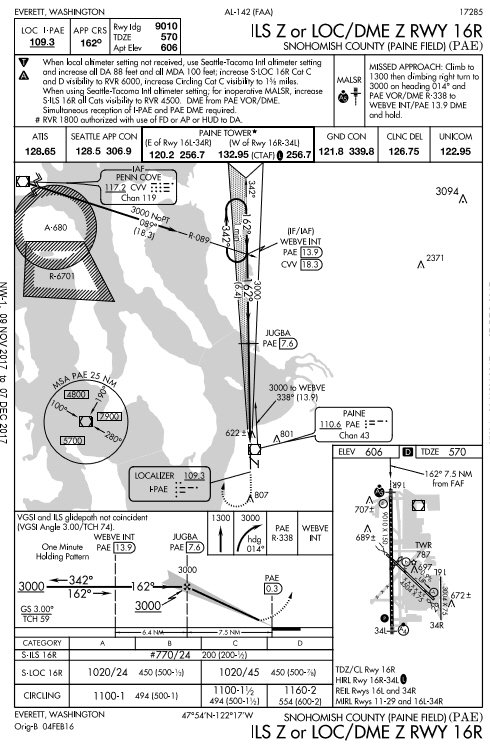I’ve recently noticed questions popping up about the letters Z, Y, X appearing in the titles of instrument approach procedures. Titles that include “-A,” “-B,” or “-C” are familiar–they designate procedures that have only circle-to-land minimums, such as the VOR-A at Olympia, WA (KOLM). But letters from the other end of the alphabet puzzle many pilots.
Note that some approaches that may appear in your navigator’s database are special procedures that you aren’t authorized to fly. For more information, see Approaches with ‘M,’ ‘N,’ etc. in the Title here at BruceAir.

For example:
- ILS Y RWY 27 and ILS Z RWY 27 at Yakima, WA (KYKM) and the RNAV (GPS) W RWY 27 and RNAV (GPS) X RWY 27 at the same airport.
- ILS OR LOC/DME Y RWY 16R and ILS Z OR LOC/DME Z RWY 16R at Snohomish County–Paine Field (KPAE) north of Seattle.
The most detailed explanation of this naming convention is in “Straight-In Procedures” in Chapter 4 of the Instrument Procedures Handbook (updated in October 2017):
When two or more straight-in approaches with the same type of guidance exist for a runway, a letter suffix is added to the title of the approach so that it can be more easily identified. These approach charts start with the letter Z and continue in reverse alphabetical order. For example, consider the (RNAV) (GPS) Z RWY 13C and RNAV (RNP) Y RWY 13C approaches at Chicago Midway International Airport…Although these two approaches can be flown with a global positioning system (GPS) to the same runway, they are significantly different (e.g., one is a Required Navigation Performance (RNP) Authorization Required (AR) … one has circling minimums and the other does not; the minimums are different; and the missed approaches are not the same). The approach procedure labeled Z has lower landing minimums than Y…
In this example, the LNAV MDA for the RNAV (GPS) Z RWY 13C has the lowest minimums of either approach due to the differences in the final approach required obstacle clearance (ROC) evaluation. This convention also eliminates any confusion with approach procedures labeled A and B, where only circling minimums are published. The designation of two area navigation (RNAV) procedures to the same runway can occur when it is desirable to accommodate panel mounted GPS receivers and flight management systems (FMSs), both with and without vertical navigation (VNAV). It is also important to note that only one of each type of approach for a runway, including ILS, VHF omnidirectional range (VOR), and non-directional beacon (NDB) can be coded into a database. (4-9)
FAA Order 8260.3E (i.e., TERPS) includes additional information:
Alphabetical suffix. When more than one procedure to the same runway uses the same type of navigation system for lateral guidance within the final approach segment, differentiate each procedure by adding a non-repeating alphabetical suffix using the letters “S” through “Z.” Suffixes are normally assigned in reverse order starting with “Z,” but may be assigned as needed to meet operational needs [for example, all RNAV (RNP) approaches at an airport assigned “Z” suffix, all RNAV (GPS) approaches assigned “Y” suffix, etc.]. (1-9)
As noted above, approaches to the same runway can be labeled Z, Y, or X… for several reasons.
For example, consider the ILS RWY 27 at KYKM, which is published as both the ILS Y RWY 27 and ILS Z RWY 27.
The Z version requires a non-standard climb gradient of 250 ft/nm on the missed approach procedure (see the note in the plan view), but it provides a DA of 1268 (200 AGL) with RVR 2400.



The DA on the Y version of the approach is 1725 (657 AGL) with visibility of 2 sm. So you can go much lower and to the equivalent of 1/2 sm visibility if you can achieve the steeper climb gradient on the miss.
There are two versions of the ILS RWY 16R–but for a different reason–at Snohomish County–Paine Field (KPAE) north of Seattle.
Both procedures offer the same basic DA and visibility minimums (although the Z version allows a reduction to RVR 1800 with a flight director, autopilot or HUD). But the FAF (ITIPE) for the Y edition is 4.4 nm from the PAE VOR.

The Z version, which also has published minimums for category C and D aircraft, has a FAF (JUGBA) at 7.6 nm from the VOR.

If you’re flying a typical light GA aircraft, the Y version is much more efficient, while the Z version is better suited to jets (like the shiny new Boeings emerging from the factory at KPAE) that need more room to get established on final.
As pointed out earlier, Z, Y, and X versions of the same basic procedure may require different equipment or missed approach segments. For example, using your favorite chart-viewing app, compare the ILS Y or LOC RWY 20 and the ILS Z or LOC/DME RWY 20 at Walla Walla, WA (KALW).
The key to flying such approaches is a careful review of the entire procedure, including notes lurking on the chart. When you contact ATC, it’s also important to request the specific procedure–including the letter–that you want to fly.
And, if you’re using an IFR-approved GPS–even for situational awareness or to act as a substitute for DME or ADF when flying a ground-based approach– ensure that you load the correct procedure and verify the key fixes before you begin flying the approach.


2 thoughts on “Z, Y, X in Approach Titles”